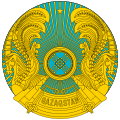| This article possibly contains original research. Please improve it by verifying the claims made and adding inline citations. Statements consisting only of original research should be removed. (October 2024) (Learn how and when to remove this message) |
| European Kazakhstan | |
|---|---|
 | |
| Largest city | Oral |
| Ethnic groups | |
| Demonym(s) | Kazakh |
| Region of Kazakhstan | |
| Area | |
| • Total | 148,000 km (57,000 sq mi) |
| Population | |
| • Census | ~1 million |
| • Density | 6.7/km (17.4/sq mi) |
European Kazakhstan (Kazakh: Europalyq Qazaqstan, Qazaqstannyñ europalyq bölıgı, Russian: Европейская часть Казахстана) is the western part of the territory of Kazakhstan. It is geographically situated in Europe, as opposed to the country's sparsely populated and vastly larger eastern part, which is situated in Central Asia. The Ural River divides Kazakhstan into two parts, bisecting the Eurasian supercontinent. European Kazakhstan geographically lies in Eastern Europe, with its area of over 148,000 square kilometres (57,000 sq mi) (approximately 5.4% of the country’s total land area) which makes Kazakhstan the 14th-largest country in Europe with a population of about 1 million. Two capitals of regions are located in European part of Kazakhstan — Uralsk and Atyrau.
Area
European Kazakhstan covers an area of over 148,000 square kilometres (57,000 sq mi), which puts Kazakhstan in 14th place in terms of territory in Europe (according to the Soviet classification of boundaries between Europe and Asia, 381,567 square kilometres (147,324 sq mi) and 7th place, respectively). The European part of Kazakhstan is located mainly on the Caspian Depression and the General Syrt upland. On the western and northern sides the territory of the Russian Federation, on the eastern side it is washed by the Ural River, on the south it is washed by the Caspian Sea and a small part of the Volga delta.
Political consequences
Main article: Kazakhstan–European Union relationsThe European Union is Kazakhstan's largest economic partner, accounting for approximately 30% of its total trade, and receiving 41% of Kazakhstan's exports. Kazakhstan is also a major recipient of foreign direct investment from the EU.
The presence of European territory in Kazakhstan is a strong argument in favor of its European status from a geographical point of view and potential membership in the European Union. In 2009, the Ambassador of Kazakhstan to Russia, Adilbek Dzhaksybekov, stated: “We would like to join the European Union in the future, but not as Estonia and Latvia, but as an equal partner.”
Bilateral relations with the European Union are regulated by the Partnership and Cooperation Agreement concluded in 1994. The expansion of Kazakhstan’s partnership and cooperation with the European Union and its member states was ratified in the country’s parliament in March 2016. Kazakhstan is also part of the EU's Central Asia New Partnership Program.
Currently, Kazakhstan is an observer in the Council of Europe, a full member of the European Commission for Democracy through Law (Venice Commission) , a member of the European Higher Education Area, the Union of European Football Associations (UEFA), etc.
References
- "EU trade relations with Kazakhstan". policy.trade.ec.europa.eu. Retrieved 17 September 2023.
- "Kazakhstan". Archived from the original on 25 February 2021. Retrieved 6 January 2024.
- "Verbatim report of proceedings - Thursday, 16 March 2006". www.europarl.europa.eu. Retrieved 17 September 2023.
- "Казахстан собрался вступить в ЕС". Lenta.RU (in Russian). 24 April 2009. Retrieved 6 January 2024.
- EU Kazakhstan Factsheet europa.eu Archived 2015-12-29 at the Wayback Machine
- "Council of EU - Newsroom". newsroom.consilium.europa.eu. Retrieved 6 January 2024.
| Kazakhstan articles | ||||||||||
|---|---|---|---|---|---|---|---|---|---|---|
| History |
|  | ||||||||
| Geography |
| |||||||||
| Politics | ||||||||||
| Economy | ||||||||||
| Culture |
| |||||||||